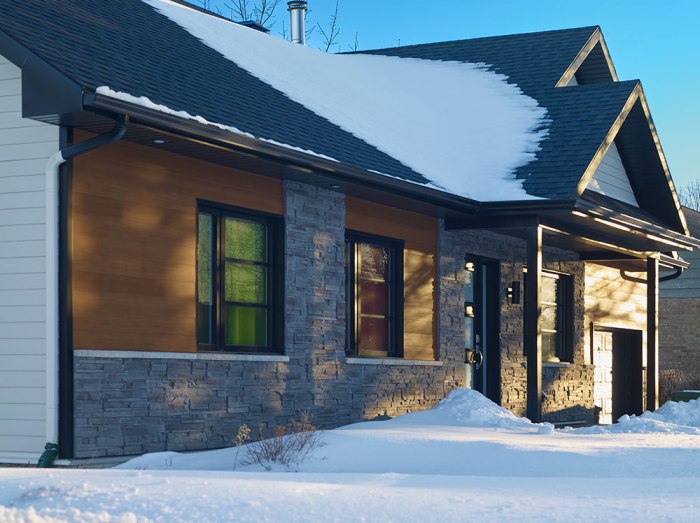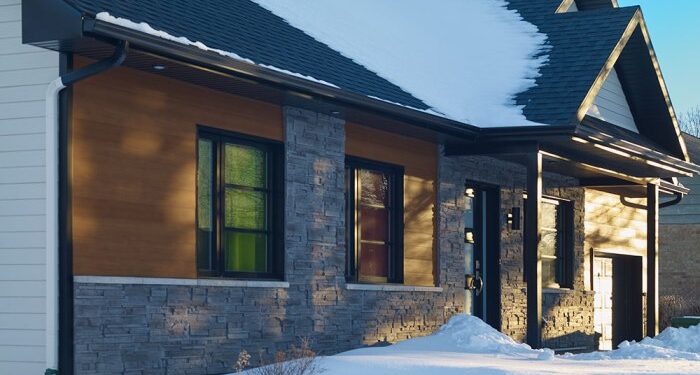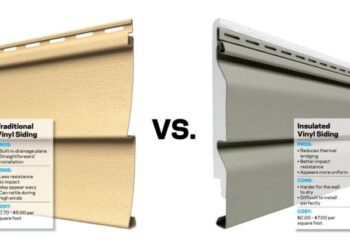Exploring the world of siding for cold climates unveils a realm of possibilities and challenges. From durable materials to innovative insulation technologies, this guide delves into the essential aspects of selecting and maintaining siding for regions with harsh winter conditions.
As we navigate through the different types of siding materials and their impact on energy efficiency, you'll gain valuable insights to make informed decisions for your home's exterior protection.
 When it comes to maintaining siding in cold climates, there are several important factors to consider. Extreme temperatures and harsh weather conditions can have a significant impact on the lifespan and appearance of your siding. By taking proper care and following some key maintenance tips, you can help prolong the life of your siding and keep your home looking its best.
When it comes to maintaining siding in cold climates, there are several important factors to consider. Extreme temperatures and harsh weather conditions can have a significant impact on the lifespan and appearance of your siding. By taking proper care and following some key maintenance tips, you can help prolong the life of your siding and keep your home looking its best.
 When it comes to installing siding in cold climates, there are several challenges that contractors and homeowners may face. The extreme temperatures, freezing conditions, and snow can all impact the installation process. It is important to be aware of these challenges and implement best practices to ensure a successful installation.
When it comes to installing siding in cold climates, there are several challenges that contractors and homeowners may face. The extreme temperatures, freezing conditions, and snow can all impact the installation process. It is important to be aware of these challenges and implement best practices to ensure a successful installation.
Types of Siding Materials for Cold Climates
When choosing siding materials for cold climates, it is important to consider factors like durability, insulation, and cost-effectiveness. Different materials offer varying benefits and drawbacks in these areas.Vinyl Siding
Vinyl siding is a popular choice for cold climates due to its durability and low maintenance. It provides decent insulation and is resistant to moisture, making it ideal for regions with harsh winters. However, vinyl can crack in extreme cold temperatures, and color fading may occur over time.Fiber Cement Siding
Fiber cement siding is another option known for its durability and resistance to temperature fluctuations. It offers excellent insulation properties and is resistant to pests and fire. While it is more expensive than vinyl, fiber cement siding is long-lasting and requires minimal upkeep.Wood Siding
Wood siding provides a classic, natural look that many homeowners appreciate. It offers good insulation but requires regular maintenance to prevent rot, warping, and insect damage. In cold climates, wood siding may be prone to moisture-related issues if not properly sealed and maintained.Engineered Wood Siding
Engineered wood siding is a more cost-effective alternative to traditional wood siding. It is designed to resist moisture and insects better, making it a suitable option for cold climates. However, it may not offer the same level of insulation as natural wood and could be prone to fading over time.Metal Siding
Metal siding, such as steel or aluminum, is highly durable and can withstand extreme weather conditions, including cold temperatures. It offers excellent insulation and requires minimal maintenance. However, metal siding can dent easily and may be more expensive than other materials.Brick Siding
Brick siding is known for its longevity and insulating properties, making it a great choice for cold climates. It is resistant to fire, pests, and rot, but it can be costly to install initially. Brick siding may also require occasional tuck-pointing to maintain its appearance and structural integrity.Insulation Properties
Insulation is a crucial aspect of siding for cold climates as it helps regulate indoor temperature, reduce energy costs, and improve overall comfort within a home. Different siding materials offer varying levels of insulation, impacting the energy efficiency of a building.Traditional Insulation Materials
- Fiberglass: Commonly used in siding, fiberglass insulation is cost-effective and offers good thermal performance.
- Wood: Wood siding provides natural insulation but may require additional insulation materials for optimal efficiency.
- Vinyl: Vinyl siding can be paired with foam insulation to enhance thermal resistance and energy savings.
Innovative Insulation Technologies
- Spray Foam Insulation: Applied as a liquid, spray foam expands to fill gaps and create a seamless barrier for superior insulation.
- Insulated Siding: Some siding materials come with integrated insulation backing to enhance thermal performance without adding bulk.
- Reflective Insulation: Utilizing reflective barriers to redirect heat, this technology helps maintain indoor temperatures in extreme weather conditions.
Maintenance Considerations
 When it comes to maintaining siding in cold climates, there are several important factors to consider. Extreme temperatures and harsh weather conditions can have a significant impact on the lifespan and appearance of your siding. By taking proper care and following some key maintenance tips, you can help prolong the life of your siding and keep your home looking its best.
When it comes to maintaining siding in cold climates, there are several important factors to consider. Extreme temperatures and harsh weather conditions can have a significant impact on the lifespan and appearance of your siding. By taking proper care and following some key maintenance tips, you can help prolong the life of your siding and keep your home looking its best.
Impact of Extreme Temperatures
Extreme temperatures, such as freezing cold winters and hot summers, can cause siding materials to expand and contract, leading to cracks, warping, or other damage. This can compromise the integrity of the siding and reduce its effectiveness in protecting your home from the elements. It is essential to choose siding materials that are designed to withstand these temperature fluctuations and to regularly inspect for any signs of damage.Maintenance Tips
- Regularly clean your siding to remove dirt, debris, and mold that can accumulate over time.
- Inspect your siding for any cracks, gaps, or damage, and repair or replace any affected areas promptly.
- Ensure proper insulation behind your siding to help regulate indoor temperatures and prevent moisture buildup.
- Trim any trees or bushes near your home to prevent damage from branches rubbing against the siding.
- Consider applying a fresh coat of paint or sealant to protect your siding from the elements and extend its lifespan.
Installation Challenges
 When it comes to installing siding in cold climates, there are several challenges that contractors and homeowners may face. The extreme temperatures, freezing conditions, and snow can all impact the installation process. It is important to be aware of these challenges and implement best practices to ensure a successful installation.
When it comes to installing siding in cold climates, there are several challenges that contractors and homeowners may face. The extreme temperatures, freezing conditions, and snow can all impact the installation process. It is important to be aware of these challenges and implement best practices to ensure a successful installation.
Temperature Variations
One of the main challenges when installing siding in cold climates is dealing with temperature variations. Materials such as vinyl or wood siding can contract and expand with changes in temperature. This can lead to gaps or buckling if not properly addressed. To mitigate this issue, it is crucial to acclimate the siding materials to the temperature of the installation site before starting the installation. This will help minimize the effects of contraction and expansion.Frozen Ground
Another common challenge is dealing with frozen ground during the installation process. Frozen soil can make it difficult to properly anchor the siding, leading to potential stability issues. In such cases, it is recommended to use specialized equipment or techniques to thaw the ground before installation. This will ensure a secure and long-lasting installation.Snow and Ice Buildup
Snow and ice buildup can also pose challenges during siding installation in cold climates. Accumulated snow and ice can hinder access to the installation site and create safety hazards for workers. It is important to clear the area of snow and ice before starting the installation process. Additionally, using proper safety equipment such as non-slip shoes and harnesses is essential to prevent accidents.Condensation and Moisture Control
Condensation and moisture control are crucial considerations when installing siding in cold climates. The temperature differentials between the interior and exterior of a building can lead to condensation buildup, which can affect the performance and lifespan of the siding. Proper insulation and vapor barriers should be installed to manage moisture levels and prevent damage to the siding materials.Material Handling
Lastly, handling siding materials in freezing temperatures can be challenging. Cold weather can make materials brittle and prone to breakage. It is important to handle the materials with care and avoid dropping or mishandling them. Additionally, using proper tools and equipment designed for cold weather conditions can help streamline the installation process.Energy Efficiency
When it comes to cold climates, the energy efficiency of a home is crucial to keeping heating costs down and maintaining a comfortable living environment. The choice of siding can significantly impact the overall energy efficiency of a house.Impact of Siding Choices
The type of siding material used can have a direct effect on the energy efficiency of a home in cold climates. For example, some materials like insulated vinyl siding or fiber cement siding offer better thermal insulation properties compared to others, thus reducing heat loss and energy consumption.Strategies for Improving Energy Efficiency
One effective strategy to enhance energy efficiency through proper siding selection is to opt for materials with high R-values, which indicate better insulation capabilities. Additionally, choosing siding with airtight construction and minimal thermal bridging can further improve the overall energy performance of a home.Examples of Energy-Efficient Siding Solutions
- Insulated Vinyl Siding: This type of siding comes with foam insulation backing that helps reduce heat transfer and can improve the energy efficiency of a home.
- Fiber Cement Siding: Known for its durability and thermal resistance, fiber cement siding can contribute to better energy performance by minimizing heat loss.
- Engineered Wood Siding: Engineered wood products with added insulation can provide good energy efficiency benefits while offering a natural wood look.







